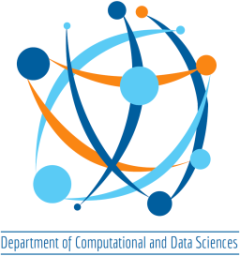Department of Computational and Data Sciences
Introduction to Scalable Systems
- Instructor: Sathish Vadhiyar (www | email), Yogesh Simmhan (www | email) and Matthew Jacob (www | email)
- Teaching Assistant: TBD
- Course number: DS221
- Credits: 3:0
- Semester: Aug, 2017
- Lecture: Tue/Th 1130AM-1PM (First class: Aug 3, 1130AM)
- Room: CDS 202
This is the website for Aug, 2017. For latest course website, see https://cds.iisc.ac.in/courses/ds221/
Overview
This course covers computer systems topics that are essential for students engaging in computational and data sciences. It introduces topics on architecture, OS and data structures that may be new to students without a degree in Computer Science. Then it moves to more advanced topics on tree/graph data structures, HPC/GPGPU programming and Big Data platforms.
Some of the topics covered are: Architecture: computer organization, single-core optimizations including exploiting cache hierarchy and vectorization, parallel architectures including multi-core, shared memory, distributed memory and GPU architectures; Algorithms and Data Structures: algorithmic analysis, overview of trees and graphs, algorithmic strategies, concurrent data structures; Parallelization Principles: motivation, challenges, metrics, parallelization steps, data distribution, PRAM model; Parallel Programming Models and Languages: OpenMP, MPI, CUDA; Distributed Computing: Commodity cluster and cloud computing; Distributed Programming: MapReduce/Hadoop model.
This course is a precursor to more advanced courses like DS 295: Parallel Programming, and DS 256: Scalable Systems for Data Science, and includes topics from the earlier DS 286: Data Structures and Programming, and DS 292: High Performance Computing courses.
Pre-requisites
This is an introductory crash-course on computer systems, algorithms, HPC and Big Data platforms. So the pre-requisites are minimal: Basic knowledge of computer systems, data structures and programming, and algorithms. However, the course will have a rapid pace and students are expected to pick up the skills rapidly through self-learning.
Grading Scheme
- Sessionals
- Two mid-Term exams (Sep 14, Oct 19) – 20
- 4 assignments – 30
- Terminal
- Final exam (December 9 forenoon) – 50
Resources
- Parallel Computing Architecture. A Hardware/Software Approach. David Culler, Jaswant Singh. Publisher: Morgan Kauffman. ISBN: 981-4033-103. 1999.
- Parallel Computing. Theory and Practice. Michael J. Quinn. Publisher: Tata: McGraw-Hill. ISBN: 0-07-049546-7. 2002.
- Computer Systems – A Programmer’s Perspective. Bryant and O’Hallaron. Publisher: Pearson Education. ISBN: 81-297-0026-3. 2003.
- Introduction to Parallel Computing. Ananth Grama, Anshul Gupta, George Karypis, Vipin Kumar. Publisher: Addison Wesley. ISBN: 0-201-64865-2. 2003.
- An Introduction to Parallel Programming. Peter S Pacheco. Publisher: Morgan Kauffman. ISBN: 978-93-80931-75-3. 2011.
- Online references for OpenMP, MPI, CUDA
- Data Structures, Algorithms, and Applications in C++, 2nd Edition, Sartaj Sahni*,**
- Lecture slides
Tentative Schedule
- Aug 3, Introductory class
- Architecture (8 lectures/MJT and VSS)
- Midterm Exam 1
- Algorithms and Data Structures: (6 lectures/YS)
- Big Data Systems (3 lectures/YS)
- Midterm Exam 2 (Oct 19)
- Parallelization Principles (4 lectures/VSS) pdf
- Motivation & Challenges of parallel computing
- Metrics and scalability laws
- Parallelization Steps – decomposition, minimizing communication and synchronization, mapping
- Data distributions
- Reading on the above: Grama et al. – 3.1, 3.5, 5.1-5.6; Culler and Singh – 2.2, 2.3
- An ideal parallelism model – PRAM pdf
- Reading: Book “Parallel Computing: Theory and Practice” by Michael J Quinn, Available with me. Pages 25-32, 40-42, 256
- Parallel Programming Models and Languages (5 lectures/VSS)
- Shared memory: OpenMP pdf
- Reading: OpenMP tutorial: http://www.llnl.gov/computing/tutorials/openMP
- Distributed Memory: MPI – pt2pt, collectives pdf
- Online tutorial “MPI Complete Reference”. Google for it.
- GPUs: CUDA pdf
- Further reading: Google for NVIDIA CUDA programming guide.
- Shared memory: OpenMP pdf
- Sample Parallel Algorithms
- Prefix computations pdf
- Graph algorithms pdf
- Paper: A Scalable Distributed Parallel Breadth-First Search Algorithm on BlueGene/L. Yoo et al. SC 2005. (Pages 1-7)
- Paper: Accelerating large graph algorithms on the GPU using CUDA. Harish and Narayanan. HiPC 2007. (Page 5-8)
- Prim’s MST, Dijikstra’s MST, Parallel APSP using Dijikstra’s SSSP: Introduction to Parallel Computing by Grama et al. – Pages 432-440
- Coloring: Maximal Independent sets by Luby – “Introduction to Parallel Computing” Book
- Coloring: Paper “Scalable parallel graph coloring algorithms” by Gebremedhin, Manne.
- Linear algebra pdf
- Paper: Towards Dense Linear Algebra for Hybrid Accelerated Manycore Systems. Parallel Computing. 2010 (section 4.1).
- Sorting pdf
- Final Exam
Assignments
- Assignment 2
[Posted on Oct 3. Due Oct 13, 11:59PM. 10% weightage]
- Assignment 3 [Posted on Oct 21. Due on Oct 31, 11:59PM. 5% weightage]
- Assignment 4 [Posted on November 3, Due: November 21. Points: 10]
- Assignment Link
- Turing cluster notes on OpenMP and MPI for the assignment
Mid-Term Answer Keys
- Mid-Term 1 – Answers-MatthewJacob, Answers-SathishVadhiyar



